Lujia Pan
AimTS: Augmented Series and Image Contrastive Learning for Time Series Classification
Apr 14, 2025Abstract:Time series classification (TSC) is an important task in time series analysis. Existing TSC methods mainly train on each single domain separately, suffering from a degradation in accuracy when the samples for training are insufficient in certain domains. The pre-training and fine-tuning paradigm provides a promising direction for solving this problem. However, time series from different domains are substantially divergent, which challenges the effective pre-training on multi-source data and the generalization ability of pre-trained models. To handle this issue, we introduce Augmented Series and Image Contrastive Learning for Time Series Classification (AimTS), a pre-training framework that learns generalizable representations from multi-source time series data. We propose a two-level prototype-based contrastive learning method to effectively utilize various augmentations in multi-source pre-training, which learns representations for TSC that can be generalized to different domains. In addition, considering augmentations within the single time series modality are insufficient to fully address classification problems with distribution shift, we introduce the image modality to supplement structural information and establish a series-image contrastive learning to improve the generalization of the learned representations for TSC tasks. Extensive experiments show that after multi-source pre-training, AimTS achieves good generalization performance, enabling efficient learning and even few-shot learning on various downstream TSC datasets.
Mantis: Lightweight Calibrated Foundation Model for User-Friendly Time Series Classification
Feb 21, 2025Abstract:In recent years, there has been increasing interest in developing foundation models for time series data that can generalize across diverse downstream tasks. While numerous forecasting-oriented foundation models have been introduced, there is a notable scarcity of models tailored for time series classification. To address this gap, we present Mantis, a new open-source foundation model for time series classification based on the Vision Transformer (ViT) architecture that has been pre-trained using a contrastive learning approach. Our experimental results show that Mantis outperforms existing foundation models both when the backbone is frozen and when fine-tuned, while achieving the lowest calibration error. In addition, we propose several adapters to handle the multivariate setting, reducing memory requirements and modeling channel interdependence.
Air Quality Prediction with Physics-Informed Dual Neural ODEs in Open Systems
Oct 25, 2024
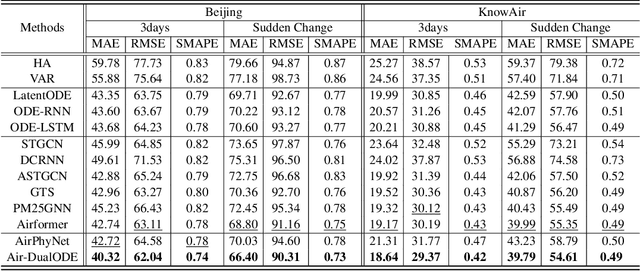
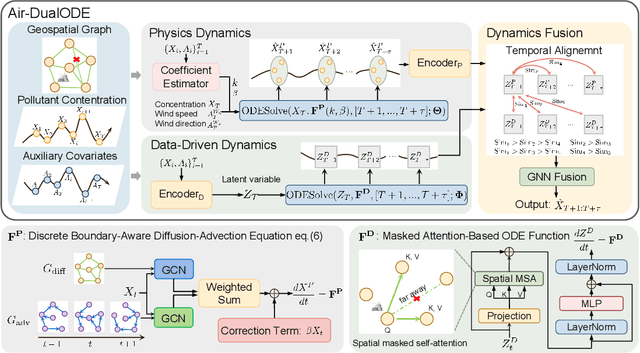
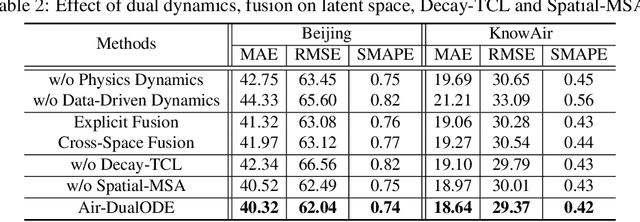
Abstract:Air pollution significantly threatens human health and ecosystems, necessitating effective air quality prediction to inform public policy. Traditional approaches are generally categorized into physics-based and data-driven models. Physics-based models usually struggle with high computational demands and closed-system assumptions, while data-driven models may overlook essential physical dynamics, confusing the capturing of spatiotemporal correlations. Although some physics-informed approaches combine the strengths of both models, they often face a mismatch between explicit physical equations and implicit learned representations. To address these challenges, we propose Air-DualODE, a novel physics-informed approach that integrates dual branches of Neural ODEs for air quality prediction. The first branch applies open-system physical equations to capture spatiotemporal dependencies for learning physics dynamics, while the second branch identifies the dependencies not addressed by the first in a fully data-driven way. These dual representations are temporally aligned and fused to enhance prediction accuracy. Our experimental results demonstrate that Air-DualODE achieves state-of-the-art performance in predicting pollutant concentrations across various spatial scales, thereby offering a promising solution for real-world air quality challenges.
SEFraud: Graph-based Self-Explainable Fraud Detection via Interpretative Mask Learning
Jun 17, 2024



Abstract:Graph-based fraud detection has widespread application in modern industry scenarios, such as spam review and malicious account detection. While considerable efforts have been devoted to designing adequate fraud detectors, the interpretability of their results has often been overlooked. Previous works have attempted to generate explanations for specific instances using post-hoc explaining methods such as a GNNExplainer. However, post-hoc explanations can not facilitate the model predictions and the computational cost of these methods cannot meet practical requirements, thus limiting their application in real-world scenarios. To address these issues, we propose SEFraud, a novel graph-based self-explainable fraud detection framework that simultaneously tackles fraud detection and result in interpretability. Concretely, SEFraud first leverages customized heterogeneous graph transformer networks with learnable feature masks and edge masks to learn expressive representations from the informative heterogeneously typed transactions. A new triplet loss is further designed to enhance the performance of mask learning. Empirical results on various datasets demonstrate the effectiveness of SEFraud as it shows considerable advantages in both the fraud detection performance and interpretability of prediction results. Moreover, SEFraud has been deployed and offers explainable fraud detection service for the largest bank in China, Industrial and Commercial Bank of China Limited (ICBC). Results collected from the production environment of ICBC show that SEFraud can provide accurate detection results and comprehensive explanations that align with the expert business understanding, confirming its efficiency and applicability in large-scale online services.
Towards a General Time Series Anomaly Detector with Adaptive Bottlenecks and Dual Adversarial Decoders
May 24, 2024Abstract:Time series anomaly detection plays a vital role in a wide range of applications. Existing methods require training one specific model for each dataset, which exhibits limited generalization capability across different target datasets, hindering anomaly detection performance in various scenarios with scarce training data. Aiming at this problem, we propose constructing a general time series anomaly detection model, which is pre-trained on extensive multi-domain datasets and can subsequently apply to a multitude of downstream scenarios. The significant divergence of time series data across different domains presents two primary challenges in building such a general model: (1) meeting the diverse requirements of appropriate information bottlenecks tailored to different datasets in one unified model, and (2) enabling distinguishment between multiple normal and abnormal patterns, both are crucial for effective anomaly detection in various target scenarios. To tackle these two challenges, we propose a General time series anomaly Detector with Adaptive Bottlenecks and Dual Adversarial Decoders (DADA), which enables flexible selection of bottlenecks based on different data and explicitly enhances clear differentiation between normal and abnormal series. We conduct extensive experiments on nine target datasets from different domains. After pre-training on multi-domain data, DADA, serving as a zero-shot anomaly detector for these datasets, still achieves competitive or even superior results compared to those models tailored to each specific dataset.
ROSE: Register Assisted General Time Series Forecasting with Decomposed Frequency Learning
May 24, 2024Abstract:With the increasing collection of time series data from various domains, there arises a strong demand for general time series forecasting models pre-trained on a large number of time-series datasets to support a variety of downstream prediction tasks. Enabling general time series forecasting faces two challenges: how to obtain unified representations from multi-domian time series data, and how to capture domain-specific features from time series data across various domains for adaptive transfer in downstream tasks. To address these challenges, we propose a Register Assisted General Time Series Forecasting Model with Decomposed Frequency Learning (ROSE), a novel pre-trained model for time series forecasting. ROSE employs Decomposed Frequency Learning for the pre-training task, which decomposes coupled semantic and periodic information in time series with frequency-based masking and reconstruction to obtain unified representations across domains. We also equip ROSE with a Time Series Register, which learns to generate a register codebook to capture domain-specific representations during pre-training and enhances domain-adaptive transfer by selecting related register tokens on downstream tasks. After pre-training on large-scale time series data, ROSE achieves state-of-the-art forecasting performance on 8 real-world benchmarks. Remarkably, even in few-shot scenarios, it demonstrates competitive or superior performance compared to existing methods trained with full data.
Enhancing Multivariate Time Series Forecasting with Mutual Information-driven Cross-Variable and Temporal Modeling
Mar 01, 2024Abstract:Recent advancements have underscored the impact of deep learning techniques on multivariate time series forecasting (MTSF). Generally, these techniques are bifurcated into two categories: Channel-independence and Channel-mixing approaches. Although Channel-independence methods typically yield better results, Channel-mixing could theoretically offer improvements by leveraging inter-variable correlations. Nonetheless, we argue that the integration of uncorrelated information in channel-mixing methods could curtail the potential enhancement in MTSF model performance. To substantiate this claim, we introduce the Cross-variable Decorrelation Aware feature Modeling (CDAM) for Channel-mixing approaches, aiming to refine Channel-mixing by minimizing redundant information between channels while enhancing relevant mutual information. Furthermore, we introduce the Temporal correlation Aware Modeling (TAM) to exploit temporal correlations, a step beyond conventional single-step forecasting methods. This strategy maximizes the mutual information between adjacent sub-sequences of both the forecasted and target series. Combining CDAM and TAM, our novel framework significantly surpasses existing models, including those previously considered state-of-the-art, in comprehensive tests.
MATA*: Combining Learnable Node Matching with A* Algorithm for Approximate Graph Edit Distance Computation
Nov 04, 2023



Abstract:Graph Edit Distance (GED) is a general and domain-agnostic metric to measure graph similarity, widely used in graph search or retrieving tasks. However, the exact GED computation is known to be NP-complete. For instance, the widely used A* algorithms explore the entire search space to find the optimal solution which inevitably suffers scalability issues. Learning-based methods apply graph representation techniques to learn the GED by formulating a regression task, which can not recover the edit path and lead to inaccurate GED approximation (i.e., the predicted GED is smaller than the exact). To this end, in this work, we present a data-driven hybrid approach MATA* for approximate GED computation based on Graph Neural Networks (GNNs) and A* algorithms, which models from the perspective of learning to match nodes instead of directly regressing GED. Specifically, aware of the structure-dominant operations (i.e.,node and edge insertion/deletion) property in GED computation, a structure-enhanced GNN is firstly designed to jointly learn local and high-order structural information for node embeddings for node matchings. Second, top-k candidate nodes are produced via a differentiable top-k operation to enable the training for node matchings, which is adhering to another property of GED, i.e., multiple optimal node matchings. Third, benefiting from the candidate nodes, MATA* only performs on the promising search directions, reaching the solution efficiently. Finally, extensive experiments show the superiority of MATA* as it significantly outperforms the combinatorial search-based, learning-based and hybrid methods and scales well to large-size graphs.
Mitigating Semantic Confusion from Hostile Neighborhood for Graph Active Learning
Aug 17, 2023Abstract:Graph Active Learning (GAL), which aims to find the most informative nodes in graphs for annotation to maximize the Graph Neural Networks (GNNs) performance, has attracted many research efforts but remains non-trivial challenges. One major challenge is that existing GAL strategies may introduce semantic confusion to the selected training set, particularly when graphs are noisy. Specifically, most existing methods assume all aggregating features to be helpful, ignoring the semantically negative effect between inter-class edges under the message-passing mechanism. In this work, we present Semantic-aware Active learning framework for Graphs (SAG) to mitigate the semantic confusion problem. Pairwise similarities and dissimilarities of nodes with semantic features are introduced to jointly evaluate the node influence. A new prototype-based criterion and query policy are also designed to maintain diversity and class balance of the selected nodes, respectively. Extensive experiments on the public benchmark graphs and a real-world financial dataset demonstrate that SAG significantly improves node classification performances and consistently outperforms previous methods. Moreover, comprehensive analysis and ablation study also verify the effectiveness of the proposed framework.
Contrastive Shapelet Learning for Unsupervised Multivariate Time Series Representation Learning
Jun 02, 2023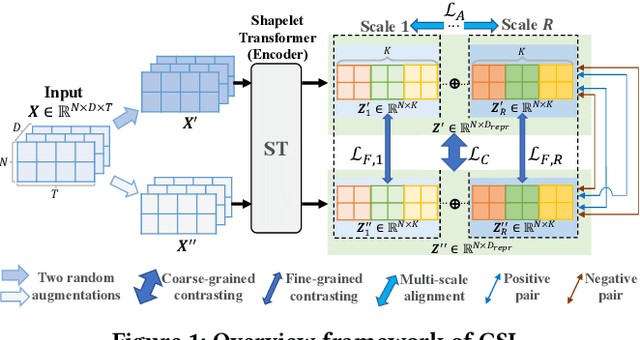

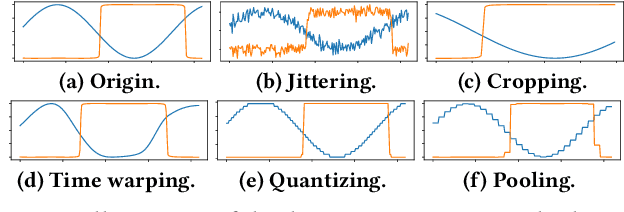
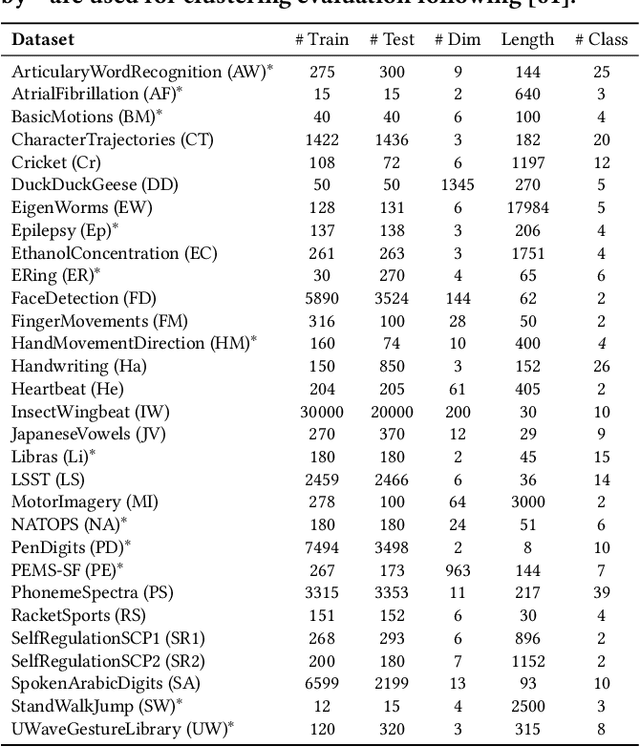
Abstract:Recent studies have shown great promise in unsupervised representation learning (URL) for multivariate time series, because URL has the capability in learning generalizable representation for many downstream tasks without using inaccessible labels. However, existing approaches usually adopt the models originally designed for other domains (e.g., computer vision) to encode the time series data and rely on strong assumptions to design learning objectives, which limits their ability to perform well. To deal with these problems, we propose a novel URL framework for multivariate time series by learning time-series-specific shapelet-based representation through a popular contrasting learning paradigm. To the best of our knowledge, this is the first work that explores the shapelet-based embedding in the unsupervised general-purpose representation learning. A unified shapelet-based encoder and a novel learning objective with multi-grained contrasting and multi-scale alignment are particularly designed to achieve our goal, and a data augmentation library is employed to improve the generalization. We conduct extensive experiments using tens of real-world datasets to assess the representation quality on many downstream tasks, including classification, clustering, and anomaly detection. The results demonstrate the superiority of our method against not only URL competitors, but also techniques specially designed for downstream tasks. Our code has been made publicly available at https://github.com/real2fish/CSL.
 Add to Chrome
Add to Chrome Add to Firefox
Add to Firefox Add to Edge
Add to Edge